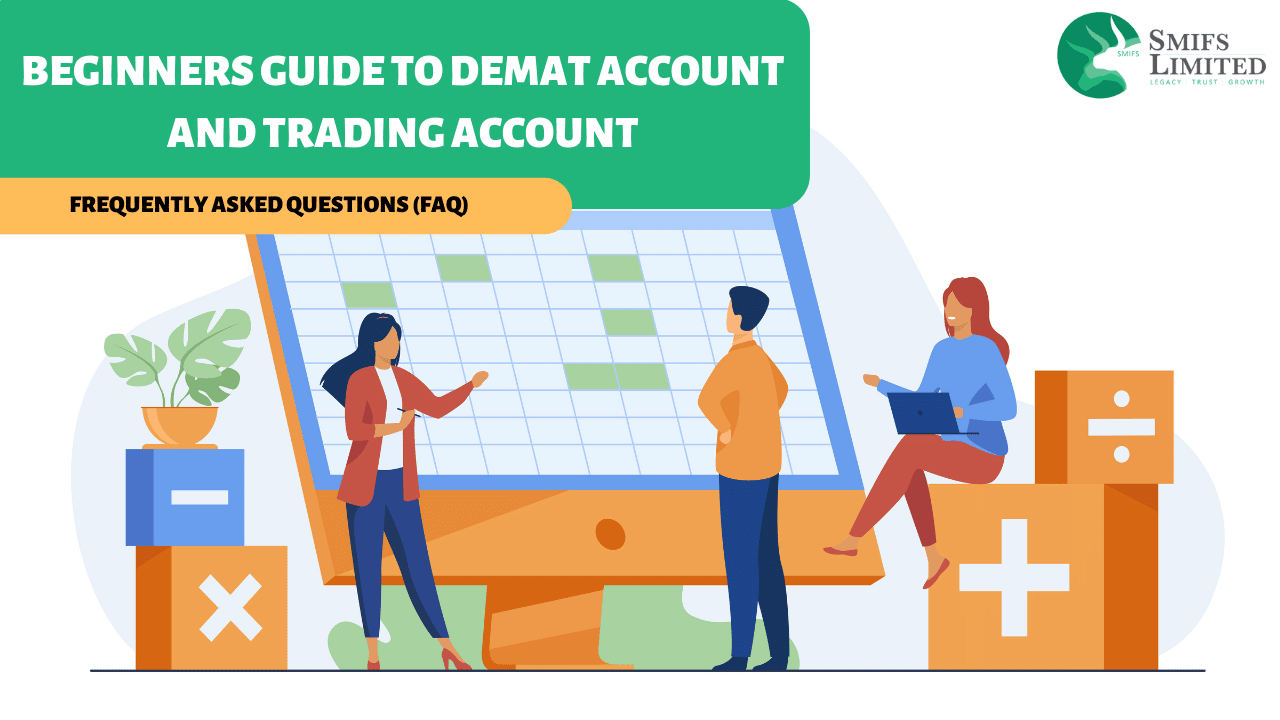Welcome to SMIFS limited. We have a legacy that has been running since 1993. Our main motto lies in Research & Advisory Services, primarily catering to Institutional clients & Ultra High Net-worth Individuals with a professional team of analysts. We provide services like Brokerage, Portfolio Management, Research & Advisory, Investment Banking, Mutual Fund, IPO and FPO to our customers.
Demat Account in general refers to a method of holding stocks and securities in an electronic manner. At SMIFS, we offer our customers free Demat Account and Trading Account opening. Below is a list of all the FAQs related to Demat Account-
FREQUENTLY ASKED QUESTIONS [FAQ]
1. What is Demat Account and Trading Account?
A Demat Account helps an investor/trader store his securities in dematerialized form. Whereas a Trading Account helps an investor/trader in buying or selling his securities.
2. Why should we open Demat Account and Trading Account?
One has to have a Trading Account in order to buy/sell securities in the Securities Market. And in order to hold the bought securities, one has to have a Demat Account.
3. When to open Demat Account and Trading Account?
Investors can always open Demat Account and Trading Account when they want to start investing in the Securities Market.
4. Who can open Demat Account and Trading Account?
Any person living in India and having an age of 18 or above shall be eligible to open Demat Account and Trading Account.
5. How to open free Demat Account and Trading Account?
There are several companies that provide Demat Account and Trading Account opening for free. At SMIFS, clients can get free Demat Account and Trading Account at a very low rate of brokerage.
6. Is Demat Account and Trading Account necessary for Systematic Investment Plans (SIPs)?
No, SIPs do not require Demat Account and Trading Account.
7. What is the procedure for opening a Demat Account and Trading Account?
The procedure for opening of Demat Account and Trading Account at SMIFS is very easy.
- Go to https://www.smifs.com and click on ‘Open an Account’.
- Type in the details in the required field using name and registered mobile number.
- Once done, wait till the form is approved.
- Finally, e-sign into the account by verifying it with the OTP twice.
You can also go to the “steps to fill an e-KYC form” for a detailed understanding.
8. What is Depository?
A depository is a place which can hold financial securities. Just like a bank account stores cash in digital format, a depository also stores any form of financial assets in paperless format. Both the NSDL and CDSL are depositories.
9. What is a Depository Participant?
A depository participant is a person who acts as a mediator between the depository and the investors. SMIFS is a Depository Participant.
10. Is depository participant important?
Yes, a depository participant makes it easy to trade securities. Also, it reduces the transaction costs of the clients.
11. What is DP ID?
The DP or the Depository Participant Identification is an ID that is provided to the Depository Participant by the Depository (i.e., NSDL or CDSL). The account number of the client is generally made up of both the DP ID and the customer ID.
12.Can I open more than one Demat Account and Trading Account?
Yes, you can have more than one Demat Account and Trading Account. But you cannot have more than one account with the same broker.
13. Where to open Demat Account and Trading Account?
Those willing to open Demat Account and Trading Account can reach out to SMIFS for we provide free Demat Account and Trading Account opening. In case clients have a high turnover, the brokerage shall also be charged at a lower slab. Further, SMIFS also provides its clients with Dial and Trade facilities.
14. Can I open Demat Account without a trading account?
Yes, you can open Demat Account without a trading account. This facility is also available at SMIFS.
15. What are the brokerage charges in SMIFS?
The brokerage charges at SMIFS vary for every plan and are considerably low. The slab is different for different segments (cash, derivative, commodity and currency).
16. How to login to Demat Account and Trading Account?
- After creating the Demat Account and Trading Account, clients will receive a UCC (Unique Client Code) on their email ID.
- Android users will have to download the ‘SMIFS ELITE’ app from Google Play Store and Apple Users will have to download ‘S&MI Pro’ for doing the trading.
- Enter the UCC code in the User ID slot provided via the welcome email and reset the password.
- Set the M-PIN. Clients can also enable ‘Quick Access Fingerprint’ as per their convenience.
- Click on ‘I agree to the Terms and Conditions’.
Note: Client can select the script from the given watch list or create his\her own.
- After putting in the details, clients can view their Trading Account from the mobile app.
17. When do shares get credited to Demat Account and Trading Account?
It takes Transaction +2 days for the shares to get credited to the Demat Account.
18. What is minor Demat Account and Trading Account?
Minor Demat Account and Trading Account is for citizens who are less than 18 years of age. These accounts, though they belong to a minor, shall be managed by a guardian till the person becomes an adult. The guardian of the minor should be the father, and in his absence, the mother. In case both are not there, the court shall have the right to appoint a guardian.
19. Which Demat Account and Trading Account is best for first time investors?
As a first-time investor, one can go for SMIFS. SMIFS offers recommendations on a regular basis along with call and trade facility. Thus, clients can call anytime on 03340115400 to take suggestions on vital matters. SMIFS also provides free Demat Account opening to its customers.
20. What are the documents required to open a Demat Account and Trading Account?
There are certain documents that are required for opening a Demat Account and Trading Account with SMIFS namely;
- PAN Card
- Valid e-mail ID
- Aadhaar Card
- Bank Statement
- Signature
- Latest photograph
21. Can I open Demat Account and Trading Account without Aadhaar OTP?
It is mandatory to have an Aadhaar card linked with a valid mobile number to open a Demat Account and Trading Account. Further, the Aadhaar card should be linked with a valid PAN card before the account opening starts to process.
22. What is NSDL Demat Account ?
The NSDL (National Securities Depository Limited) is one of the oldest providers of Demat Account and Trading Account services. Any account that is created under them shall be known as the NSDL Demat Account.
23. What is CDSL Demat Account ?
The CDSL (Central Depository Services Limited) is another government registered depository that provides services for securities and Demat Account and Trading Accounts.
24. What are the Annual Maintenance Charges in Demat Account and Trading Account?
The Annual Maintenance Charges for retail clients at SMIFS is INR 300/- + 18% GST. For Corporate clients, the charges are INR 800/-+ 18%.
25. Why does SMIFS charge an AMC in Demat Account and Trading Account?
SMIFS charges a minimal AMC as an expense for maintaining the securities of the client in the Demat Account and Trading Account.
26. Is Demat Account and Trading Account required for IPO?
No, it is not necessary to have both Demat Account and Trading Account for IPO.
27. Can I open a Demat Account and Trading Account without a broker?
No, it is not possible to open a Demat Account and Trading Account without a broker. The Demat Account and Trading Account are always opened by a broker under a depository .
28. Why is POA (Power Of Attorney) required for Demat Account and Trading Account?
POA refers to ‘Power of Attorney’. The POA is a must for those clients who want their broker to act on their behalf. This will give them the power to make decisions regarding the transfer of power to the client in matters associated with the account. Also, the client is required to give POA to his\her stock broker if they want to buy or sell securities online.
29. When does a Demat Account or a Trading Account become dormant?
If a client does not cause any trading from its Demat Account and Trading Account, it will become dormant after a time period of 1 year from the last date of transaction.
30. Where can I see my Demat Account and Trading Account?
All Demat Account and Trading Accounts shall be visible on the CDSL and NSDL website. Those who have an account with SMIFS shall be able to check their securities and trading from the ‘New Client Back Office’ option (https://backoffice.smifsltd.com/LdclientlevelH/Index.html#Login).
31. How to operate Trading and Demat account?
- Once you have opened your Demat Account and Trading Account, you need to link them to your bank account.
- Request an order through your trading account to start trading. Your broker will connect once it gets a suitable trading exchange to trade.
- The order for the exchange then gets processed digitally.
Finally, the Demat Account and Trading Account gets debited/credited according to the transaction. You will also get confirmation, via your registered email and phone number.
32. How to open Demat Account and Trading Account without income proof?
The documents required for opening a Demat account varies for different brokerage houses. Here in SMIFS, income proof is not a mandatory document for opening a Demat Account and a Trading Account.
33. How to open HUF Demat Account and Trading Account online?
SMIFS does not have any facility to open an HUF Demat Account and Trading Account online. Users can get this service offline only. The documents required to open an HUF Demat Account and Trading Account offline includes:
- PAN Card of individual member
- HUF PAN card of the individual member
- Aadhaar card of all the family member
- Passport size photograph
- Cancelled cheque
34. What is the benefit of opening Demat Account and Trading Account?
Demat Account and Trading Account has several benefits. These include:
- Transferring securities in a short notice
- No stamp duty required while transferring these securities
- Eliminating risks related to physical certificates.
- A reduction in the paperwork
- A reduction in the transaction cost
35. How to open NSDL Demat Account and Trading Account?
The account opening for NDSL is very simple. All you need to do is to-
- Get in touch with the registered DP (SMIFS)
- Fill in the KYC documents (PAN, Address proof and bank details)
- Submit the documents to the DP and wait till it gets verified.
- After verification, the DP will open a Demat Account and Trading Account on behalf of the client. All the details like the NSDL Demat Account and Trading Account number, DP ID, client ID, client master sheet, tariff sheet and a sheet of rights and obligations shall be provided to you.
36. What are the types of Demat Account and Trading Account?
The three different types of Demat Account and Trading Account include Regular account for Indian Citizens and Repatriable account & Non-Repatriable account for NRI citizens.
37. How can I get my Demat Account and Trading Account details?
SMIFS provides the option of choosing either NSDL or CDSL while opening a Demat Account and Trading Account. Once the account is ready, you shall receive a letter from your chosen depository, containing all information regarding your Demat Account and Trading Account.
38. How to access SMIFS Demat Account and Trading Account through NSDL?
- Go to https://eservices.nsdl.com/
- Click on ‘Register online for IDeAS’.
- Enter the DP ID, client ID and mobile number
- Enter verification code and submit. Client will then be able to access the consolidated account statement of the Demat Account.
39. What is the procedure to transfer stocks from one Demat Account and Trading Account to another?
- The investor has to fill a DIP (Delivery Instruction Slip) and submit it to their broker.
- The broker shall carry forward the DIP and transfer the stocks to the required Demat Account and Trading Account.
- Once done, the investor shall be able to see its securities in the account.
40.Where can I find my Demat Account and Trading Account number?
The Demat Account and Trading Account number shall be sent to you by your depository participant in the form of a letter as well as through email.
41. Is nomination necessary for Demat Account and Trading Accounts?
Earlier, it was not necessary to have a nominee for Demat Account and Trading Accounts. But, on February 23, 2022, SEBI released a circular declaring that everybody shall have a nominee. In case, an owner without a nominee expires, then the legal heirs shall have to make a request for transmission of the beneficial ownership to their name. However, if a client does not want to keep a nominee, he/she can provide a declaration as to why he/she is not interested in keeping a nominee.
42. Can a Demat Account and Trading Account have joint holders?
Yes, a Demat Account and Trading Account can have joint holders. These holders will have to submit their documents directly to the DP.
43. How to close a Demat Account and Trading Account?
If a client wants to close a Demat Account and Trading Account, he/she will need to fill up and submit a closure form. In case, the client has certain pending formalities to be fulfilled, he/she will not be allowed to close the account unless the documents are cleared.
44. Can one Demat Account and Trading Account be used for two or more brokers?
Certainly not. Any client shall be allowed to have only one trading and Demat Account and Trading Account with only one broker.
We hope that this questionnaire will be very useful in understanding all aspects of Demat Account and Trading Account under SMIFS Limited. For further queries, contact 9830121215.





